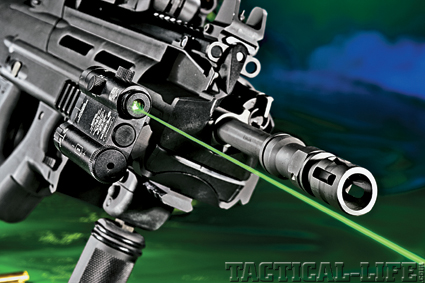The FS2000 CQB employs a forward ejection system where brass is ejected through a covered port to the right of the gas block.
The AR is the dominant tactical carbine platform in LE circles. To argue any differently would be at odds with observable fact. The reasons behind this are numerous—its long military service career, decades of combat-refined enhancement and broad operational familiarity with former and current members of the U.S. military, to name just a few. The AR has also set the trend for the firearms designs of the future—namely ones with in-line stock systems, use of advanced alloys and plastics, and modular configurations. However, by that same token, it is a design that has been around for nearly five decades—a very long tenure for any weapon system.

The 5.56mm FS2000 CQB bullpup is a new variant of this advanced design that features a tri-rail forend system for accessories. Shown equipped with an EOTech HWS optic, a Laserlyte Kryptonyte K-15, a Laser Devices DBAL-A3 with a green pointer (532 nm) and an Accu-Shot BT27 vertical foregrip.
Advertisement — Continue Reading Below
Accepting that the basic AR was the first generation of the modern tactical carbine, then it is safe to say that over the past few years we have begun to see the birth of the second-generation wave of designs. From the FN SCAR to the Bushmaster ACR to the Beretta ARX160, these new platforms have taken the application of ultra-modern materials and cutting-edge modularity to the next level. But all of the designs still follow the traditional approach to firearm design—namely a barrel protruding forward of the action, and a buttstock jutting out rearward.

The bullpup design of the FS2000 locates the action and magazine behind the pistol grip and in the “buttstock” of the carbine. Note the large buttpad.
This brings us to the bullpup, a concept simultaneously ultra-advanced yet surprisingly steeped in tradition. For the uninitiated, the bullpup is a design in which the action, magazine and firing mechanism are located behind the pistol grip and trigger rather than forward of it, combining the benefits of longer barrels with ultra-short overall lengths. Clearly, this approach is a paradigm shift away from traditional long-arm design. And, as advanced and radical as it may seem, the concept has actually been around in tactical weapons circles for quite a while, dating back most notably to the British EM-2, a post-World War II bullpup carbine that combined advanced engineering with an equally radical .280 cartridge. An even more iconic example is the Steyr StG 77 (better known to most shooters as the “AUG”).
Advertisement — Continue Reading Below

To allow visual access to the chamber, the CQB features an inspection door. The “switch” that carries fired cases up to the ejection tube is shown.























